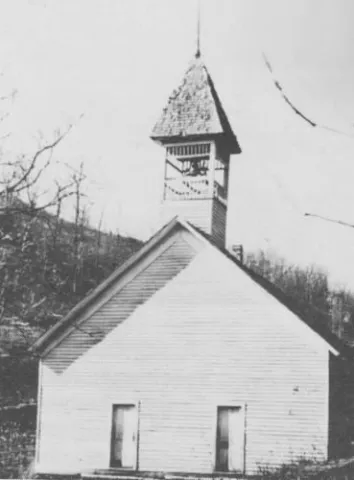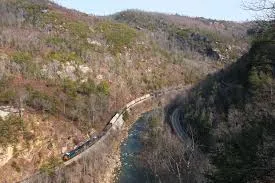A Spring Trip Through the Narrows Between Morley and Highcliff

A spring trip through the Narrows along U.S. Hwy 25W, between Morley and Highcliff, aboard an ETHRA rural transportation van, was an unexpected treat for a local history writer. Since my release from a convalescent home in late September, I had not attempted to operate a motor vehicle.
The natural beauty along the stretch of federal highway that parallels the Clearfork River through the Narrows is one of the best kept secrets of the Cumberlands. A fast-moving CSX freight train passing through multiple rock hewn tunnels, on the opposite bank of the river within the narrow gorge, would have only added to the ambience.
I hadn’t planned on a scenic excursion when I left home in the early afternoon, but those familiar with ETHRA’s rural transportation service know to expect the unexpected. My plans for the day had revolved around a trip to decorate graves of relatives at the area’s only GAR cemetery.
The Grand Army of the Republic (GAR) was a Union Veterans’ organization. When the GAR’s meeting house in Sugar Hollow, that also housed the congregation of the Sugar Hollow Baptist Church, was sold to TVA, as plans were being implemented for the impoundment of the Clinch and Powell rivers behind Norris Dam, one of the few living local Civil War veterans, GAR member Nicholas B. Grant (Co F. 6th Tennessee Infantry), proposed that the proceeds be used to purchase land to be used as a memorial cemetery to the GAR. To the best of my knowledge, Grant is the only Civil War Veteran buried at Baker’s Forge Memorial Cemetery that was not moved there by TVA from another cemetery in the Norris Reservoir area. Most of the disinterment cemeteries from which graves were moved to BFMC were along the Powell or its tributaries, but a few such as Mount Moriah, in Anderson county, were below the forks of the river.
The attachment that Appalachian people feel to family burial grounds is a defining feature of our culture. Five generations of my family are buried within a short section of a swath at BFMC beginning with my Great-Great Grandparents, William and Louisa Craig Cannon, who lived on Powell River and buried their dead in a small family cemetery on the family farm. I can’t possibly decorate all of my relatives’ graves at BFMC around Decoration Day and at Christmas, but I try to decorate the Cannon graves.
As the nation came apart in 1861, the Cannons were strong supporters of the Union, However, William and his oldest son John, felt that they were needed more at home than on the battlefield. When word would spread along Powell River that troops were in the area, looking for men and boys to be forcibly conscripted into the military, they hid in hollow logs. One of the younger Cannon daughters, my Great Grandmother Susan, remembered soldiers plunging their swords into the sides of the corncrib in search of men and boys who might be attempting to avoid military conscription. Her aunt, Mary Craig, hid livestock on an island surrounded by the swift moving Powell River. Aunt Mary left her name on the island until it was submerged deep beneath what was, until fairly recent times, the placid surface of Norris Reservoir.
At the cemetery, I handed off my decorations to my cousin’s husband who had been patiently waiting for me there. I encouraged him to come back to the cemetery, when the temperatures were cooler to decorate with his wife, before I pushed my walker to my brother’s grave. I hadn’t been back to the cemetery since we buried him last June.
Then I and re-boarded the van for the trek up Big Creek Gap, across Peabody Mountain, and through the Narrows to pick up another passenger at Jellico.
After I got home, I remembered a humorous anecdote from my youth. Some readers will remember the small roadside park at the Bear’s Den Spring, along U.S. Hwy 25W in the Narrows, with its one picnic table. Sitting there with a college friend, in the early 1980s, we observed a woman pull up in an old station wagon and begin to fill the most amazing assortment of containers with water from the spring. My friend remarked “You have some mighty interesting jugs”. Of course, I burst out laughing. Fortunately, the lady with the jugs was not offended. Her collection of jugs even included Clorox bottles which she said would purify the water.
This building housed the Sugar Hollow Baptist Church and a Grand Army of the Republic Post (GAR)
An areal view of the Narrows between Highcliff and Morely (below Jellico)
- Log in to post comments
